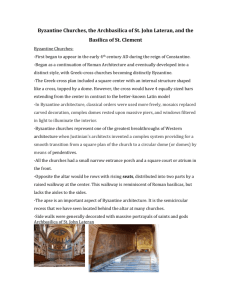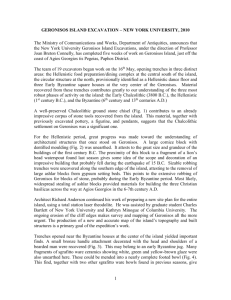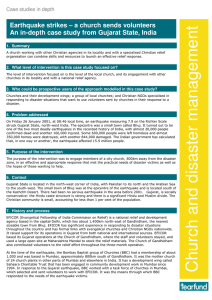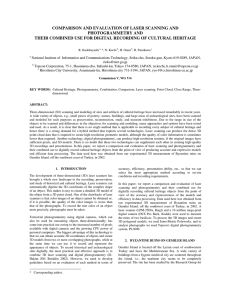INTEGRATED PRESENTATION SYSTEM FOR 3D MODELS AND IMAGE DATABASE FOR
advertisement
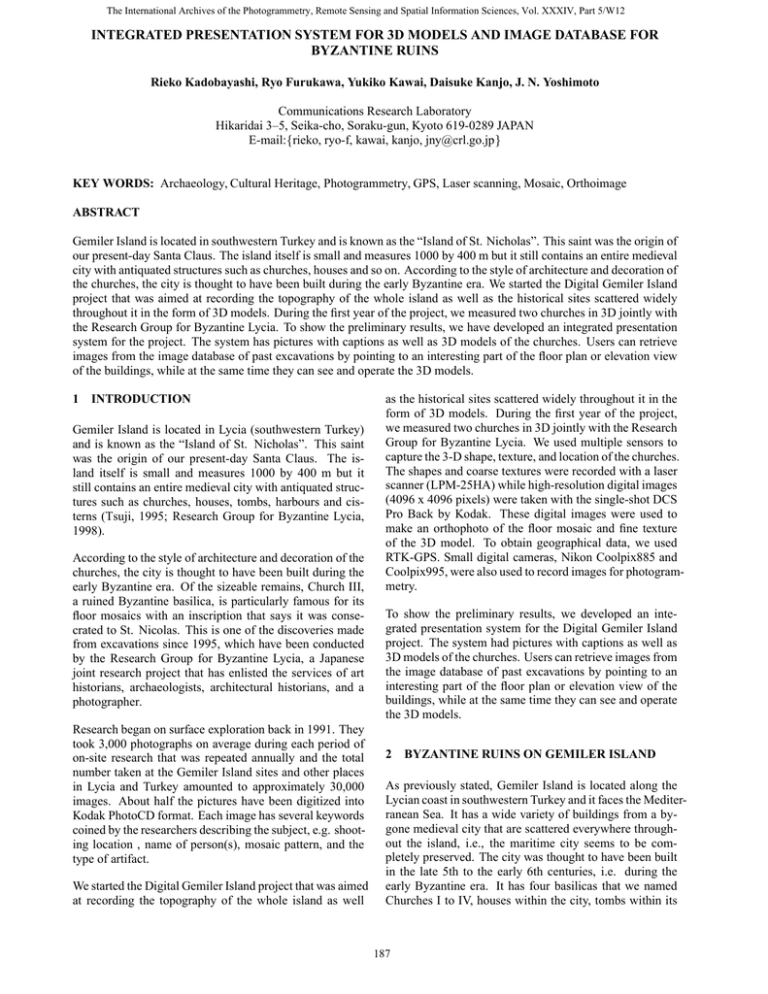
The International Archives of the Photogrammetry, Remote Sensing and Spatial Information Sciences, Vol. XXXIV, Part 5/W12 INTEGRATED PRESENTATION SYSTEM FOR 3D MODELS AND IMAGE DATABASE FOR BYZANTINE RUINS Rieko Kadobayashi, Ryo Furukawa, Yukiko Kawai, Daisuke Kanjo, J. N. Yoshimoto Communications Research Laboratory Hikaridai 3–5, Seika-cho, Soraku-gun, Kyoto 619-0289 JAPAN E-mail:frieko, ryo-f, kawai, kanjo, jny@crl.go.jpg KEY WORDS: Archaeology, Cultural Heritage, Photogrammetry, GPS, Laser scanning, Mosaic, Orthoimage ABSTRACT Gemiler Island is located in southwestern Turkey and is known as the “Island of St. Nicholas”. This saint was the origin of our present-day Santa Claus. The island itself is small and measures 1000 by 400 m but it still contains an entire medieval city with antiquated structures such as churches, houses and so on. According to the style of architecture and decoration of the churches, the city is thought to have been built during the early Byzantine era. We started the Digital Gemiler Island project that was aimed at recording the topography of the whole island as well as the historical sites scattered widely throughout it in the form of 3D models. During the first year of the project, we measured two churches in 3D jointly with the Research Group for Byzantine Lycia. To show the preliminary results, we have developed an integrated presentation system for the project. The system has pictures with captions as well as 3D models of the churches. Users can retrieve images from the image database of past excavations by pointing to an interesting part of the floor plan or elevation view of the buildings, while at the same time they can see and operate the 3D models. 1 INTRODUCTION Gemiler Island is located in Lycia (southwestern Turkey) and is known as the “Island of St. Nicholas”. This saint was the origin of our present-day Santa Claus. The island itself is small and measures 1000 by 400 m but it still contains an entire medieval city with antiquated structures such as churches, houses, tombs, harbours and cisterns (Tsuji, 1995; Research Group for Byzantine Lycia, 1998). According to the style of architecture and decoration of the churches, the city is thought to have been built during the early Byzantine era. Of the sizeable remains, Church III, a ruined Byzantine basilica, is particularly famous for its floor mosaics with an inscription that says it was consecrated to St. Nicolas. This is one of the discoveries made from excavations since 1995, which have been conducted by the Research Group for Byzantine Lycia, a Japanese joint research project that has enlisted the services of art historians, archaeologists, architectural historians, and a photographer. Research began on surface exploration back in 1991. They took 3,000 photographs on average during each period of on-site research that was repeated annually and the total number taken at the Gemiler Island sites and other places in Lycia and Turkey amounted to approximately 30,000 images. About half the pictures have been digitized into Kodak PhotoCD format. Each image has several keywords coined by the researchers describing the subject, e.g. shooting location , name of person(s), mosaic pattern, and the type of artifact. We started the Digital Gemiler Island project that was aimed at recording the topography of the whole island as well as the historical sites scattered widely throughout it in the form of 3D models. During the first year of the project, we measured two churches in 3D jointly with the Research Group for Byzantine Lycia. We used multiple sensors to capture the 3-D shape, texture, and location of the churches. The shapes and coarse textures were recorded with a laser scanner (LPM-25HA) while high-resolution digital images (4096 x 4096 pixels) were taken with the single-shot DCS Pro Back by Kodak. These digital images were used to make an orthophoto of the floor mosaic and fine texture of the 3D model. To obtain geographical data, we used RTK-GPS. Small digital cameras, Nikon Coolpix885 and Coolpix995, were also used to record images for photogrammetry. To show the preliminary results, we developed an integrated presentation system for the Digital Gemiler Island project. The system had pictures with captions as well as 3D models of the churches. Users can retrieve images from the image database of past excavations by pointing to an interesting part of the floor plan or elevation view of the buildings, while at the same time they can see and operate the 3D models. 2 BYZANTINE RUINS ON GEMILER ISLAND As previously stated, Gemiler Island is located along the Lycian coast in southwestern Turkey and it faces the Mediterranean Sea. It has a wide variety of buildings from a bygone medieval city that are scattered everywhere throughout the island, i.e., the maritime city seems to be completely preserved. The city was thought to have been built in the late 5th to the early 6th centuries, i.e. during the early Byzantine era. It has four basilicas that we named Churches I to IV, houses within the city, tombs within its 187 The International Archives of the Photogrammetry, Remote Sensing and Spatial Information Sciences, Vol. XXXIV, Part 5/W12 Figure 3: Apse and semi-dome of Church II graveyard, a long wall that divides Church III and the tombs from the city, and a long corridor that connects Churches III and IV. Figure 1: View of Church III: West and south wall (top), apse and bema (bottom) Standing at just below the top of the island which is at an altitude of 99 m, Church III can easily be noticed from ships sailing on the Mediterranean Sea. It has three aisles and measures approximately 30 x 15 m. Generally, the south and west of the basilica, i.e. the atrium and west and south wall are well preserved, whereas the north and east, i.e., the semi-dome of the apse and the east wall are not. The wooden roofs have all perished (Figure 1). What makes Church III attract a lot of attention is its floor mosaic, which have appeared from the ruins as excavation progressed. The inscription that tells it was dedicated to St. Nicolas was unearthed along with inlays of cows, birds, goats, flowers, trees, and fish (Figure 2). That is, Church III is the oldest basilica dedicated to St. Nicolas at present in the world (Research Group for Byzantine Lycia, 2002). Church II, standing halfway up the western slope of the island, has three-aisles and it measures about 20 x 10 m. The semi-dome of the apse and the north wall are well preserved (Figure 3). Some frescos remain decorating the walls around the entrance and the windows. A floor mosaic was also found there. 3 DATA COLLECTION The Research Group for Byzantine Lycia conducted their annual summer research project from August 24, 2002 to September 20, 2002. We joined the survey for the first half of the period and spent 11 days at the site to obtain the 3D laser data, the RTK-GPS geographical data, the digital images recorded with the three different cameras, and the survey data. Figure 2: Floor mosaics of Church III The major tasks that were carried out are listed below. 188 Setup and recording of reference points The International Archives of the Photogrammetry, Remote Sensing and Spatial Information Sciences, Vol. XXXIV, Part 5/W12 3.1 3D measurement with Riegl LPM-25HA laser scanner Survey of reference points with total station Survey of reference points with RTK-GPS system Shooting of high-resolution images for texture with a camera system composed of Kodak DCS Pro Back and Hasselblad 555ELD Shooting of images for photogrammetry with a Nikon Coolpix885 and a Coolpix995 Setting reference points Figure 4: View of scanning at Church II All images have to be registered because each image has its own coordinate system based on the location of the scanner when creating 3D models by merging scanned 3D images. These images should be oriented according to the geographical coordinate system since, traditionally, archaeologists have been using this to record the location of their sites. We placed reflecting targets (1 x 1 cm) on the floor and the wall of the churches so that these could be extracted from the 3D images automatically and then used as reference points to register the images. The reflecting targets’ coordinates were measured by topographically surveying with the total station. It took five days for measuring about 140 reflecting targets at Church III and one day for measuring about 20 reflecting targets at Church II. Compared to usual archaeological surveys done in Japan, it was more time consuming, due to glaring sunlight which prevented the target from reflecting the sunlight toward the total station, and the limited working time at the site which was approximately six hours a day. 3.2 Laser Scanning The main target of laser scanning was Church III since several years of excavation have unearthed the floor mosaic decorating the nave and aisles, the synthronon (priests seat) covered with marble slabs in the apse, the bema (sanctuary) where marble columns and capitals were found, and many artifacts such as relief fragments that decorate the basilica. Church II was chosen because its semi-dome of the apse is well preserved, and because its round shape and height made it difficult to measure accurately with the traditional topographical survey method. Figure 4 shows the laser scanning at Church II and Figure 5 shows an example of scanned 3D images. Accuracy requirements were different for archaeologists and architectural historians. An archaeologist’s main requirement was to create a complete 3D model of each monument so that not only researchers but also the general public could easily grasp the features of the site and this did not need a smaller sampling step. An architectural historian, on the other hand, required a sampling step of 1 cm or less assuming that the plan had been drawn to a scale of 1:100. Figure 5: Example of scanned image Topographical limitations had to be also taken into account when selecting the laser scanner. Church III was located near the top of the island while the equipment such as the scanner and RTK-GPS systems were located near the pier. As the island was uninhabited and there were no power lines, we chose the LPM-25HA laser scanner by Riegl due to its battery-driven capability, portability and sufficiently high accuracy to satisfy our requirements. Table 1 has its specifications. We located the scanner at 29 points and scanned 55 images at Church III while at Church II we used five points and obtained seven images. Figure 6 and 7 show the locations where the scanner was placed. We changed the sampling step from 0.06 gon to 0.15 gon according to the target, though most of the target was scanned with a sampling step of 0.1 gon. This was due to limited work time. When the sampling step was 0.06 gon and the target was 10 m away, the sampling step on the target was about 1 cm, while it was about 1.6 cm when the sampling step was 0.1 gon. The coverage of one scan and hence the size of the scanned 3D image also differed; the largest image was 1200 x 1800 pixels, which produced 2,160,000 point data. The total number of points scanned reached 34,105,175. 189 The International Archives of the Photogrammetry, Remote Sensing and Spatial Information Sciences, Vol. XXXIV, Part 5/W12 Specification Measurement range Measurement accuracy Measurement rate Measurement resolution Measuring beam diameter Laser wavelength Scanning range horizontally vertically Positioning accuracy Angle readout accuracy Scanning speed Scanner size Scanner weight Kodak DCS ProBack CCD 36.86 x 36.86 mm Image size 4072 x 4072 pixel Lens Distagon 50mm F4 FLE Body Hasselblad 555ELD Nikon Coolpix885 & Coolpix995 CCD 1/1.8-in. CCD Image size 2048 x 1536 pixels Lens 3x Zoom Nikkor; f=8–24mm Value 2 m – 60 m 8 mm 1000 points/sec. 1 mm 15 mm@10 m 20 mm@20 m 60 mm@60 m near infrared 180ÆÆ 150 0 009Æ (=0.01gon) 0 009Æ (=0.01gon) : : 36Æ /sec. (=40gon/sec.) 25 cm x 30 cm x 32 cm 9.5 kg Table 1: LPM-25HA laser scanner specifications Figure 6: Setup position of LPM-25HA at Church II (source Tsuji, 1995; modified by author) Table 2: Camera systems specifications 3.3 Topographical survey 3.3.1 Survey based on the local coordinate system We mounted 164 reflecting targets on the walls and floors of the two basilicas. Local coordinate systems were used such that the origin of the X and Y axes was equal to the datum point fixed on the synthronon of Church III or Church II and the Z value was based on the level of the P29 datum point. Note that we used two totally different local coordinate systems to survey Churches III and II. 3.3.2 Survey using RTK-GPS We used an RTK-GPS system to obtain the geographical data on some of the reflecting targets and some tesserae, which were small pieces comprising the mosaic, for two reasons. First, we intended to convert the local coordinate systems to the WGS 84 (World Geodetic System 1984) coordinate system so that the locations of Churches II and III could be uniquely identified. Second, we intended to produce orthophotographs of the floor mosaics using the geographical data from the tesserae. We surveyed 293 points with the RTK-GPS system, which was composed of a Legacy-E (dual frequency GPS/GLONASS receiver) and a MarAnt (dual frequency GPS/GLONASS antennae) from JAVAD Navigation Systems. 3.4 Photo shooting The cameras used to take the images are in Table 2. We used the DCS Pro Back from Kodak on a Hasselblad 555ELD with a Distagon 50 mm F4 FLE lens to record the highresolution images that were intended to be used as texture data for the 3D models. Due to the 60 % overlap required for adjacent pictures, the number reached 1300. To complement the 3D models created from the laser data, we decided to use photogrammetry. Pictures for this purpose were taken with a Coolpix885 by Nikon. 4 CREATING 3D MODELS Figure 7: Setup position of LPM-25HA at Church III (source Tsuji, 1995; modified by author) We used Polyworks from InnovMetric to align and merge the 3D images . We first created 3D models using only laser data. The size of the polygonal model of Church II in the pol format was about 2,560,000 polygons. The file size was approximately 70 MB. This will be even larger if the model is saved in VRML format. Since the size of point cloud data was too huge for the 3-D model of Church III, we first partitioned the church 190 The International Archives of the Photogrammetry, Remote Sensing and Spatial Information Sciences, Vol. XXXIV, Part 5/W12 Figure 8: Sample view of the 3D model of Church II into several sections, i.e., the apse, the south wall and other areas, and then created the 3D model that corresponded to each section. These separate models were then merged into one. Some section models used the original point cloud data and the others used the reduced data. The total size of the 3D polygonal model of Church III was approximately 6,300,000 polygons in the pol format. The file size was about 174 MB. Figure 8 and 9 show example view of the 3D models of Church II and III, respectively. 5 PRESENTATION SYSTEM We developed a presentation system that was capable of displaying 3D models and managing the image database (Figure 10). It included 350 images with keywords and annotations selected from about 16000 images as previously discussed, along with floor plans, maps, and 3D models of Churches II and III. The user can retrieve images through the image database by pointing to floor plans or map as well as by specifying keywords. Using the floor plans and maps, anyone who does not have knowledge about the site or Byzantine art and architecture can easily access the pictures he/she wants to see. Even experts can easily retrieve pictures without being having to be overly conscious of the terms they input into the system. The keywords for pictures may differ even if the photographic subjects are the same. The interface is shown in Figure 11. The system can be used to enter image data and edit keywords and it is also possible to print the search results in the form of a catalogue of the images. Furthermore, it has a unique function that allows the user to add information about the position and direction of camera to each particular image. This interface is such that after a floor plan is displayed on a window the user can indicate the start and end points and an arrow that shows the position and direction of camera appears on the plan. Figure 9: Sample view of the 3D model of Church III: West wall (top), apse and bema (bottom) The most important feature of this system is that the user can browse not only images in the database but also the 3D models of Churches II and III as can be seen in Figure 12. The images show the subject two-dimensionally from the front, which requires other images if the user wants to see the back of the subject. To obtain an overall grasp of the subject, several images taken from several viewpoints are needed. The 3-D models, however, can provide a complete view of the subject from arbitrary points of view. For example, if the user wants to observe how two walls are connected, he/she just needs to rotate or translate the model until a good angle is found. That is, using the 3D models as 3D maps, users can gain an intuitive understanding of the subject in a image. The images, however, have an advantage in that the resolution is usually higher than the texture of the 3D models and hence they may be more suitable for close observation of the surface of the subject. The images and 3D models actually complement each other and a system which utilizes the advantages of each can serve as a useful presentation tool. 191 The International Archives of the Photogrammetry, Remote Sensing and Spatial Information Sciences, Vol. XXXIV, Part 5/W12 6 CONCLUSIONS We reported on the 3D digitization of Byzantine ruins in Turkey and also discussed an integrated presentation system we developed. The shape of the basilicas was scanned LPM-25HA laser scanner while the texture of them was taken with Kodak DCS Pro Back on a Hasselblad 555ELD with a Distagon 50 mm F4 FLE lens. Pictures taken with a Coolpix885 or a Coolpix995 were used to make orthophoto of floor mosaics. The presentation system includes both images and 3D models, and hence users can easily view and compare both of them according to their objectives. Figure 10: Startup window of the presentation system We faced many problems when gathering and post processing the data. For example, due to the limited survey period at the site, laser scanning and excavation were carried out simultaneously and therefore the scanned 3D images were very noisy. Removing noise included in the data was very time consuming. Digitizing systems and methods for the historical site located outside require more severe conditions of robustness against disturbance, such as heat, sunlight and noise, portability, accuracy, easiness of use. In the future, we plan to digitize other structures such as a corridor, which is about 200 m long and eventually the entire terrain of Gemiler Island. 7 REFERENCES Tsuji. S., 1995. The Survey of Early Byzantine Sites in ölüdeniz Area (Lycia, Turkey). Memories of the Faculty of Letters, Osaka University, Osaka, Japan. Figure 11: Snapshot of the presentation system: plan view window (upper right), image view window (lower left), and list view window(lower right) Research Group for Byzantine Lycia, 1998. Island of St Nicholas — Excavation of Gemiler Island on Mediterranean Coast of Turkey. Research Group for Byzantine Lycia, 2002. http://www.jttk.zaq.ne.jp/sfuku239/lycia/lycia-E.htm (accessed 28 Apr. 2003) ACKNOWLEDGMENTS The authors would like to thank the Research Group for Byzantine Lycia for their support during the survey at the site and offering materials. Figure 12: Image close-up window (back) and 3D model viewer (front) 192
